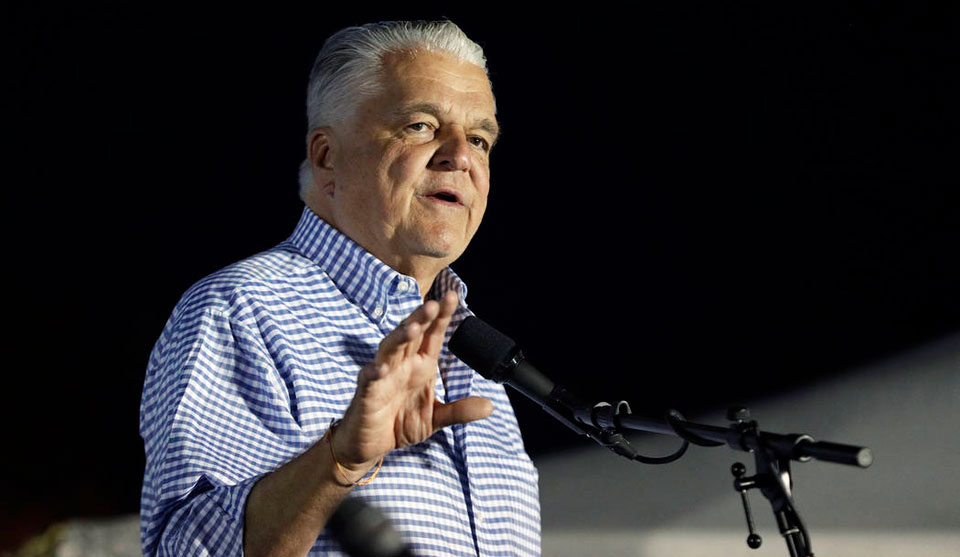
LAS VEGAS—In the state legislative session prior to the 2018 elections, 20 labor-backed bills failed. Since then, in dramatic proof of what a difference an election can make, 20 have passed
One reason is that after the vote last fall 19 of the 63 state lawmakers (30 percent) are unionists, a record. Another reason is that the new Democratic Governor, Steve Sisolak, son of an Auto Worker from Milwaukee, knows who put him in office. And the third and not least of the reasons is it helps that the Silver State’s legislature is the first-ever state legislature in U.S. history to be majority-female.
The win in Nevada was one of many nationwide in 2018. Other victories included putting union members, both Teachers, in governors’ chairs in Minnesota (Tim Walz) and Michigan (Gretchen Whitmer) and ousting rabid anti-worker anti-union GOP governors Scott Walker in Wisconsin and Bruce Rauner in Illinois in favor of pro-worker Democratic nominees.
But Nevada stood out because the GOP governor stood in the way, even after workers and their allies gained clout in Carson City, in the 2016 election. Nevada also stood out because, with a rabidly anti-worker administration in Washington, D.C., unions and workers find themselves increasingly turning to the states for support and for progressive policies.
“The tens of thousands of phone calls and doors knocked are what we have to do across the country to elect pro-union candidates,” Sisolak told the Communications Workers convention, meeting in Las Vegas on July 29.
Members of Unite Here, the Communications Workers, AFSCME and the Teamsters led the 2018 Nevada sweep. Unite Here’s largest local, in Las Vegas, has more than 50,000 members alone, concentrated in the hotels and casinos in the burgeoning Las Vegas casino-hotel Strip.
It took a lot of effort to produce those wins and create that new climate, CWA Local 9413 President Marc Elllis told the 2,000 delegates. Fifty unions joined together in the mass mobilization, putting 2,500 volunteers on the streets. The volunteers knocked on half a million dollars and held 125,000 one-on-one conversations. The numbers rose two years later. Union turnout was so huge that in 2018, 17 percent of early ballots were from union members, and one-fifth of all Clark County (Las Vegas) voters were unionists.
That made a difference: Federal calculations show Nevada is 13.9 percent unionized, with another 1.8 percent of its workers represented by unions, but not members themselves.
“In 2016-18, we sent a message: A union must join together to build a better future for our families and our state,” said Liz Sorenson, Nevada State AFL-CIO president. “We also had learned some hard lessons,” which other unions nationwide should heed, she warned.
“In 2014, our members did not mobilize and did not hear from us when we were needed. So in 2015, we spent all that time fighting constant attacks on wages, benefits and the right to organize” from the radical right Republican legislative majority and a GOP governor.
The rest of the union movement could learn that lesson, too, from Nevada, which has been a classic swing state. “The one good thing we learned from that” laxity in 2014 “was never to take elections for granted,” Sorenson said.
The success showed up in the just-finished legislative session in Carson City, with Sisolak signing all 20 pro-worker bills lawmakers sent him, plus other progressive legislation. They included:
- A new law, SB131, giving the state’s 20,000 workers the right to collectively bargain. Sisolak and the unions also negotiated a 3 percent raise.
- Laws strengthening project labor agreements, vital to construction workers’ working conditions and pay. The prior GOP governor vetoed similar legislation.
- Mandating two-person crews on all freight trains, some of which are three miles long or more. Nevada is a key state in the U.S. rail network, as lines to California, the nation’s largest market, go through its next-door neighbor state. The Nevada fight took 20 years. Illinois, another pro-worker state, and the nation’s rail hub, also now mandates two-person crews.
Railroad unions, led by the Brotherhood of Locomotive Engineers and Trainmen/Teamsters, have campaigned for such measures both in D.C. and in states, for safety reasons: A second crew member can recognize conditions that could lead to fatal, fiery and dangerous accidents. By contrast, the nation’s freight railroads push one-person crews – except for one BNSF executive, who is pushing crewless trains.
- Providing 40 hours of paid leave of all types to all workers, union and non-union, statewide.
- Raising the statewide minimum wage to $12 an hour by 2025.
- Banning state contracts for five years to rich corporations that took state subsidies, especially for building call centers, and then outsourced the jobs overseas. “Call centers are 3 percent of all U.S. jobs,” state fed Secretary-Treasurer Rusty McAllister, a Fire Fighter said. And if a firm wants to pull up and move, it must give the state 90 days’ notice, not the 60 days federal law requires.
“When pro-union bills came over, I was proud to sign every single one of them – supporting policies that are good, not just good for working families, but for America,” Sisolak concluded.










